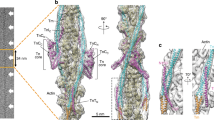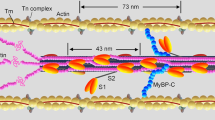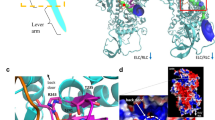Abstract
Muscle contraction involves the cyclic interaction of the myosin cross-bridges with the actin filament, which is coupled to steps in the hydrolysis of ATP1. While bound to actin each cross-bridge undergoes a conformational change, often referred to as the “power stroke”2, which moves the actin filament past the myosin filaments; this is associated with the release of the products of ATP hydrolysis and a stronger binding of myosin to actin. The association of a new ATP molecule weakens the binding again, and the attached cross-bridge rapidly dissociates from actin. The nucleotide is then hydrolysed, the conformational change reverses, and the myosin cross-bridge reattaches to actin. X-ray crystallography has determined the structural basis of the power stroke, but it is still not clear why the binding of actin weakens that of the nucleotide and vice versa. Here we describe, by fitting atomic models of actin and the myosin cross-bridge into high-resolution electron cryo-microscopy three-dimensional reconstructions, the molecular basis of this linkage. The closing of the actin-binding cleft when actin binds is structurally coupled to the opening of the nucleotide-binding pocket.
This is a preview of subscription content, access via your institution
Access options
Subscribe to this journal
Receive 51 print issues and online access
$199.00 per year
only $3.90 per issue
Buy this article
- Purchase on Springer Link
- Instant access to full article PDF
Prices may be subject to local taxes which are calculated during checkout





Similar content being viewed by others
References
Lymn, R. W. & Taylor, E. W. Mechanism of adenosine triphosphate hydrolysis by actomyosin. Biochemistry 10, 4617–4624 (1971)
Geeves, M. A. & Holmes, K. C. Structural mechanism of muscle contraction. Annu. Rev. Biochem. 68, 687–727 (1999)
Rayment, I. et al. Structure of the actin–myosin complex and its implications for muscle contraction. Science 261, 58–65 (1993)
Schröder, R. R. et al. Three-dimensional atomic model of F-actin decorated with Dictyostelium myosin S1. Nature 364, 171–174 (1993)
Volkmann, N. et al. Myosin isoforms show unique conformations in the actin-bound state. Proc. Natl Acad. Sci. USA 100, 3227–3232 (2003)
Rayment, I. et al. Three-dimensional structure of myosin subfragment-1: a molecular motor. Science 261, 50–58 (1993)
Smith, C. A. & Rayment, I. X-ray structure of the magnesium(ii).ADP.vanadate complex of the Dictyostelium–Discoideum myosin motor domain to 1.9 Å resolution. Biochemistry 35, 5404–5417 (1996)
Dominguez, R., Freyzon, Y., Trybus, K. M. & Cohen, C. Crystal structure of a vertebrate smooth muscle myosin motor domain and its complex with the essential light chain: visualization of the pre-power stroke state. Cell 94, 559–571 (1998)
Angert, I., Majorovits, E. & Schröder, R. R. Zero-loss image formation and modified contrast transfer theory in EFTEM. Ultramicroscopy 81, 203–222 (2000)
Geeves, M. A. & Conibear, P. B. The role of three-state docking of myosin S1 with actin in force generation. Biophys. J. 68, 194S–201S (1995)
Geisterfer-Lowrance, A. A. et al. A molecular basis for familial hypertrophic cardiomyopathy: a β cardiac myosin heavy chain gene missense mutation. Cell 62, 999–1006 (1990)
Sweeney, H. L., Straceski, A. J., Leinwand, L. A., Tikunov, B. A. & Faust, L. Heterologous expression of a cardiomyopathic myosin that is defective in its actin interaction. J. Biol. Chem. 269, 1603–1605 (1994)
Sasaki, N., Asukagawa, H., Yasuda, R., Hiratsuka, T. & Sutoh, K. Deletion of the myopathy loop of Dictyostelium myosin II and its impact on motor functions. J. Biol. Chem. 274, 37840–37844 (1999)
Volkmann, N. et al. Evidence for cleft closure in actomyosin upon ADP release. Nature Struct. Biol. 7, 1147–1155 (2000)
Yengo, C. M., De la Cruz, E. M., Chrin, L. R., Gaffney, D. P. & Berger, C. L. Actin-induced closure of the actin-binding cleft of smooth muscle myosin. J. Biol. Chem. 277, 24114–24119 (2002)
Conibear, P. B., Bagshaw, C. R., Fajer, P., Kovacs, M. & Malnasi-Csizmadia, A. Myosin cleft movement and its coupling to actomyosin dissociation. Nature Struct. Biol. (in the press)
Coureux, P.-D. et al. A structural state of the myosin V motor without bound nucleotide. Nature 425, 419–423 (2003)
Reubold, T., Eschenburg, S., Becker, A., Kull, F. J. & Manstein, D. J. A structural model for actin-induced nucleotide release in myosin. Nature Struct. Biol. (in the press)
Kull, F. J., Vale, R. D. & Fletterick, R. J. The case for a common ancestor: kinesin and myosin motor proteins and G proteins. J. Muscle Res. Cell Motil. 19, 877–886 (1998)
Naber, N. et al. Closing of the nucleotide binding pocket of kinesin-family motors upon binding to microtubules. Science 300, 798–801 (2003)
Margossian, S. S. & Lowey, S. Preparation of myosin and its subfragments from rabbit skeletal muscle. Methods Enzymol. 85, 55–71 (1982)
Spudich, J. A. & Watt, S. The regulation of rabbit skeletal muscle contraction. I. Biochemical studies of the interaction of the tropomyosin–troponin complex with actin and the proteolytic fragments of myosin. J. Biol. Chem. 246, 4866–4871 (1971)
Jahn, W. Easily prepared holey films for use in cryo-electron microscopy. J. Microsc. 179, 333–334 (1995)
Löbau, V. Neue Wege in der Kryo-Präparation: Die Kontroller-gesteuerte Einfrierapparatur. Thesis, Univ. Stuttgart (1997)
Frank, J. et al. SPIDER and WEB: processing and visualization of images in 3D electron microscopy and related fields. J. Struct. Biol. 116, 190–199 (1996)
Egelmann, E. H. A robust algorithm for the reconstruction of helical filaments using single particle methods. Ultramicroscopy 85, 225–234 (2000)
Schroeder, R. R., Angert, I., Frank, J. & Holmes, K. C. Multivariate statistical analysis and tomographic processing of helical objects. Proc. 15th Int. Congr. Elec. Microsc. 3, 443–444 (2002)
Yagle, A. E. in Discrete Tomography (eds Herman, G. T. & Kuba, A.) (Birkhäuser, Boston, 1999)
Esnouf, R. M. Further additions to Molscript version 1.4, including reading and contouring of electron-density maps. Acta Crystallogr. D 55, 938–940 (1999)
Kraulis, P. J. MOLSCRIPT: a program to produce both detailed and schematic plots of protein structures. J. Appl. Crystallogr. 24, 946–950 (1991)
Merritt, E. & Bacon, D. Raster 3D: photorealistic molecular graphics. Methods Enzymol. 277, 505–524 (1997)
Acknowledgements
We thank J. Frank for discussions, support and encouragement, and P. Bele for technical assistance during image processing.
Author information
Authors and Affiliations
Corresponding author
Ethics declarations
Competing interests
The authors declare that they have no competing financial interests.
Supplementary information
41586_2003_BFnature02005_MOESM11_ESM.zip
Supplementary Information: This Zip file contains 6 files, 5 are in pdb format and one is in Brix format. 3actin.pdb: F-actin model, showing 3 actin monomers, axis.pdb: orientation of upper 50K domain rotation axis (depicted as pseudo-Ca-chain), motor_domain.pdb: myosin model excluding the residues of the upper 50K domain , original_upper_50K_domain.pdb: upper 50K domain in its crystallographic position (Rayment et al., 1993), upper_50K_domain.pdb: upper 50K domain in its rotated, strong binding position, em_density.brix: reconstructed density from present EM study. For further information on PDB format please see http://www.rcsb.org/pdb/index.html (ZIP 1499 kb)
Rights and permissions
About this article
Cite this article
Holmes, K., Angert, I., Jon Kull, F. et al. Electron cryo-microscopy shows how strong binding of myosin to actin releases nucleotide. Nature 425, 423–427 (2003). https://doi.org/10.1038/nature02005
Received:
Accepted:
Issue Date:
DOI: https://doi.org/10.1038/nature02005
Comments
By submitting a comment you agree to abide by our Terms and Community Guidelines. If you find something abusive or that does not comply with our terms or guidelines please flag it as inappropriate.



